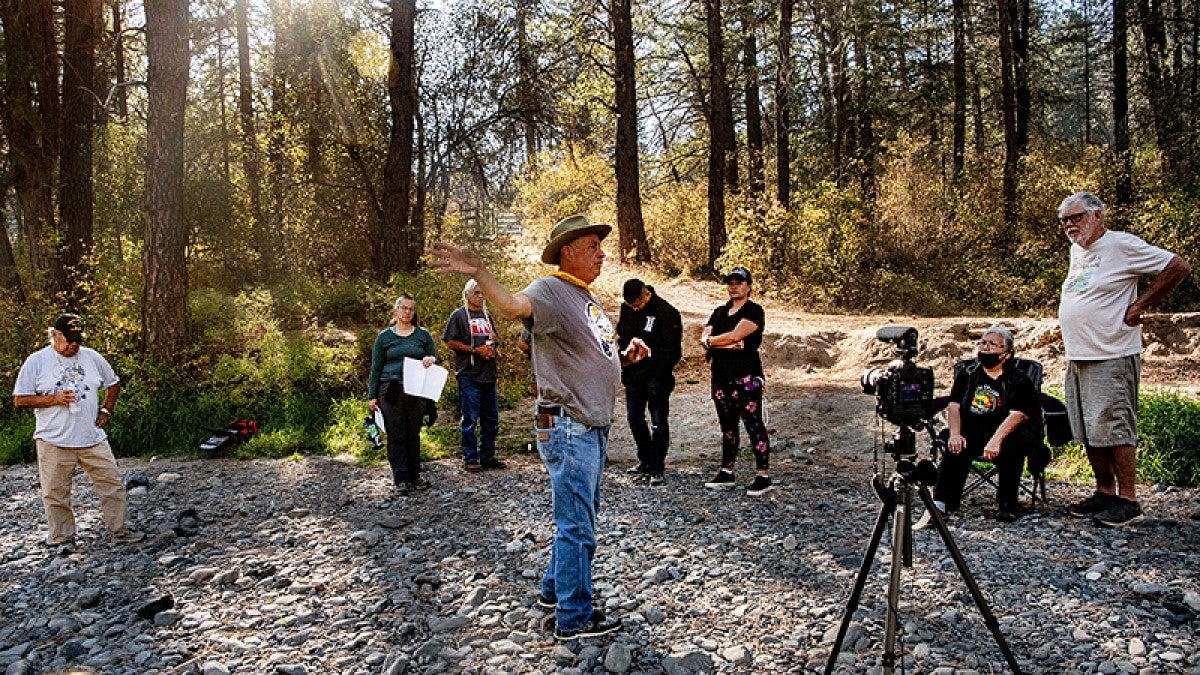The Museum of Natural and Cultural History has bestowed the sixth annual Oregon Stewardship Award to Heads to Hearts, a project of the Josephy Center for Arts and Culture.
Administered by the museum’s advisory council, the award recognizes a project that has significantly involved its community in an environmental or cultural heritage project, one that aligns with the museum's mission to inspire stewardship of our collective past, present and future.
Heads to Hearts explores the confluence between Indigenous and scientific understanding of place. Suggested by interpretive specialist and Indigenous artist Roger Amerman, the project has a specific focus on Nez Perce stories of landscapes and linking them with scientific geological and botanical knowledge of those landscapes to provide a more complete understanding of the landscape in Nez Perce lands in Northeastern Oregon, Western Idaho and Southeastern Washington.
After a beading workshop, Amerman approached Rich Wandschneider, head of the Josephy Library of Western History and Culture at the center.
“At the end of it he said, ‘You know, we have ethnobotany and ethnobiology, why don’t we have ethnogeography? Why don’t we start looking at the land not only through the lens of scientific understanding but also through the eyes of Native elders?’” Wandschneider said.
The project has been hosting expeditions to various sites around Northeastern Oregon, Western Idaho, and Southeastern Washington with Nez Perce elders. One two-day boating trip on the Snake River brought along several Nez Perce high school student photographers. On the trips, the elders share stories and knowledge of the landscape.
The project highlights the center’s mission of homecoming. Traditional homelands of the Nez Perce include portions of Northeastern Oregon, but after their forcible removal at the hands of the U.S. government, few Nez Perce have returned.
“Part of our goal has been to make the Nez Perce feel that they can return with a welcome,” said Cheryl North Coughlan, executive director of the center. “Here we are, an institution, telling people to come together to talk about Native stories, science and land, and it’s all coming together.”
The center will continue hosting excursions through 2023, and the project will culminate with an exhibit in 2024 that will include video of all the sites.
“The museum’s stewardship mission brings us into contact with Oregon heroes every day, people doing amazing work to protect and preserve our ecosystems, landscapes and cultures,” said Ann Craig, associate director at the Museum of Natural and Cultural History. “The Heads to Hearts project exemplifies innovative work that brings together Indigenous knowledge and scientific understanding.”
The Heads to Hearts program was chosen out of a group of five finalists. Other finalists include:
Eugene Lesbian Oral History Project
Eugene
The Eugene Lesbian History Project is an ongoing cultural heritage project collecting and archiving the oral histories of women who came to Eugene, Oregon in the 1960s through 1990s and created one of the largest and most active lesbian communities in the world.
Friends of Buford Park and Mount Pisgah Native Plant Nursery
Eugene
The Friends of Buford Park and Mount Pisgah work to conserve Mount Pisgah’s botanical, wildlife and recreational values. The native plant nursery cultivates 130 species of native plants to restore habitat, maintain local biodiversity, and nurture community among people and place.
Jumping Into Fire
Philomath
The Philomath community hosted “Jumping Into Fire,” a Veterans Day event honoring the 555th Parachute Infantry Battalion, the “Triple Nickles.” The event commemorated the Pendleton-based Black Army unit dedicated to fighting fires set by enemy bombs in Oregon’s forests during World War II.
Vanport Mosaic
Vanport/Portland
In 1948, the temporary city of Vanport was destroyed in a flood that killed 15 and displaced 18,700 residents. The Vanport Mosaic uses oral history recordings, theater, exhibits and screenings to amplify, honor, and preserve the histories of this multi-racial, working-class community.
—By Lexie Briggs, Museum of Natural and Cultural History
—Top photo: Geologist and enrolled Choctaw tribal member Roger Amerman talks with Nez Perce elders and younger descendants from Chief Joseph's band (Nespelem, Washington) about geology and native plants at a tribal gathering site along the Minam River.


